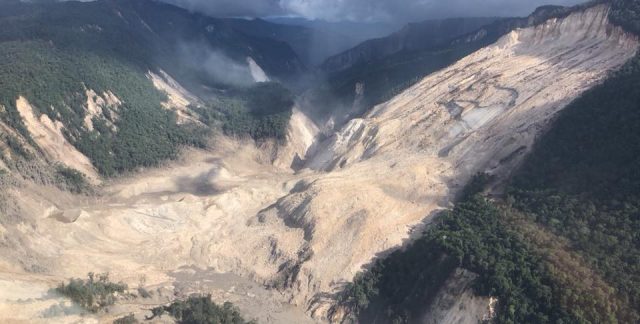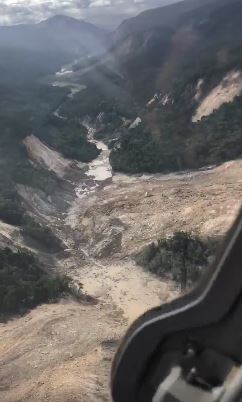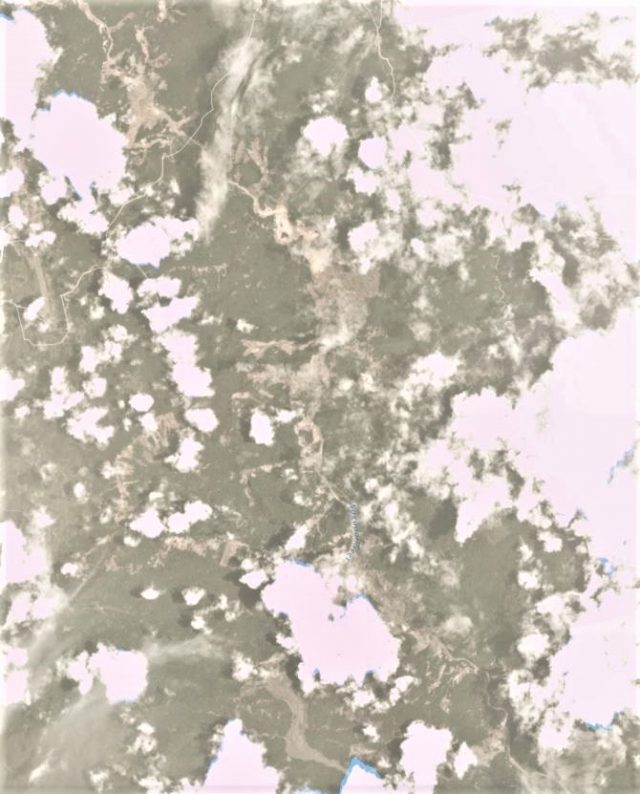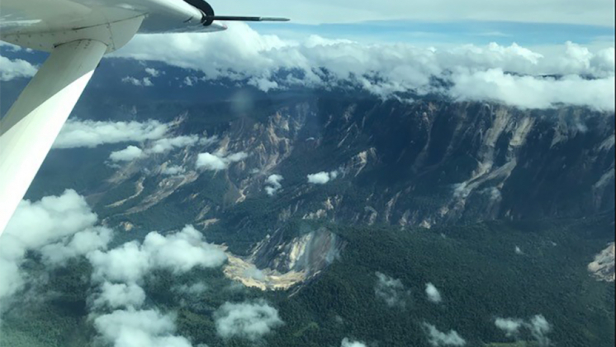*******************************************************************************************************
Smithsonian / USGS Weekly Volcanic Activity Report, 20 December-26 December 2017
*******************************************************************************************************
Sally Kuhn Sennert - Weekly Report Editor (kuhns@si.edu)
URL: http://volcano.si.edu/reports_weekly.cfm
New Activity/Unrest: Agung, Bali (Indonesia) | Bezymianny, Central Kamchatka (Russia) | Kanlaon, Philippines | Klyuchevskoy, Central Kamchatka (Russia) | Pacaya, Guatemala
Ongoing Activity: Aira, Kyushu (Japan) | Bagana, Bougainville (Papua New Guinea) | Dukono, Halmahera (Indonesia) | Ebeko, Paramushir Island (Russia) | Karymsky, Eastern Kamchatka (Russia) | Kilauea, Hawaiian Islands (USA) | Nevados de Chillan, Chile | Oraefajokull, Iceland | Sheveluch, Central Kamchatka (Russia) | Sinabung, Indonesia
The Weekly Volcanic Activity Report is a cooperative project between the Smithsonian's Global Volcanism Program and the US Geological Survey's Volcano Hazards Program. Updated by 2300 UTC every Wednesday, notices of volcanic activity posted on these pages are preliminary and subject to change as events are studied in more detail. This is not a comprehensive list of all of Earth's volcanoes erupting during the week, but rather a summary of activity at volcanoes that meet criteria discussed in detail in the "Criteria and Disclaimers" section. Carefully reviewed, detailed reports on various volcanoes are published monthly in the Bulletin of the Global Volcanism Network.
Note: Many news agencies do not archive the articles they post on the Internet, and therefore the links to some sources may not be active. To obtain information about the cited articles that are no longer available on the Internet contact the source.
New Activity/Unrest
Agung | Bali (Indonesia) | 8.343°S, 115.508°E | Summit elev. 2997 m
PVMBG reported that during 20-26 December gray-and-white plumes rose as high as 2 km above Agung's crater rim and drifted W and E; weather clouds and fog sometimes prevented visual observations. Incandescence from the crater was sometimes observed at night. BNPB reported that during 22-23 December events generated dense gray ash plumes that rose as high as 2.5 km above the crater rim and drifted NE. Ash fell on the flanks and in Tulamben, Kubu. As of 25 December there were 71,045 evacuees spread out in 239 shelters. The Alert Level remained at 4 (on a scale of 1-4), and the exclusion zones continued at a general 8-km radius and 10 km in the NNE, SE, S, and SW directions.
Geologic Summary. Symmetrical Agung stratovolcano, Bali's highest and most sacred mountain, towers over the eastern end of the island. The volcano, whose name means "Paramount," rises above the SE caldera rim of neighboring Batur volcano, and the northern and southern flanks extend to the coast. The summit area extends 1.5 km E-W, with the high point on the W and a steep-walled 800-m-wide crater on the E. The Pawon cone is located low on the SE flank. Only a few eruptions dating back to the early 19th century have been recorded in historical time. The 1963-64 eruption, one of the largest in the 20th century, produced voluminous ashfall along with devastating pyroclastic flows and lahars that caused extensive damage and many fatalities.
Sources: Pusat Vulkanologi dan Mitigasi Bencana Geologi (PVMBG, also known as CVGHM) http://vsi.esdm.go.id/; Badan Nacional Penanggulangan Bencana (BNPB) http://www.bnpb.go.id/
Bezymianny | Central Kamchatka (Russia) | 55.972°N, 160.595°E | Summit elev. 2882 m
KVERT reported that ash plumes from the 20 December explosive eruption at Bezymianny rose as high as 15 km (49,200 ft) a.s.l. and drifted 320 km NE. A thermal anomaly over the volcano was identified in satellite images during 21-22 December. The Aviation Color Code remained at Orange.
Geologic Summary. Prior to its noted 1955-56 eruption, Bezymianny had been considered extinct. The modern volcano, much smaller in size than its massive neighbors Kamen and Kliuchevskoi, was formed about 4700 years ago over a late-Pleistocene lava-dome complex and an ancestral edifice built about 11,000-7000 years ago. Three periods of intensified activity have occurred during the past 3000 years. The latest period, which was preceded by a 1000-year quiescence, began with the dramatic 1955-56 eruption. This eruption, similar to that of St. Helens in 1980, produced a large horseshoe-shaped crater that was formed by collapse of the summit and an associated lateral blast. Subsequent episodic but ongoing lava-dome growth, accompanied by intermittent explosive activity and pyroclastic flows, has largely filled the 1956 crater.
Source: Kamchatkan Volcanic Eruption Response Team (KVERT) http://www.kscnet.ru/ivs/kvert/index_eng.php
Kanlaon | Philippines | 10.412°N, 123.132°E | Summit elev. 2435 m
PHIVOLCS reported that during 19-20 December there were 412 volcanic earthquakes detected at Kanlaon. A low-energy, explosion-type earthquake was detected at 0233 on 21 December associated with gas emissions from the summit area. Later in the day steam plumes rose 400 m and drifted NE. The number of daily volcanic earthquakes increased to 957 the next day and then decreased to less than 20 per day during 22-23 December; the daily count increased to 382 and 776 events on 24 and 25 December, respectively, and then decreased to 82 on 26 December. White plumes rose 300 m and drifted NE, NW, and SW on 21 December, and 700 m on 26 December; weather clouds prevented views on the other days. The Alert Level remained at 2 (on a scale of 0-5).
Geologic Summary. Kanlaon volcano (also spelled Canlaon), the most active of the central Philippines, forms the highest point on the island of Negros. The massive 2435-m-high andesitic stratovolcano is dotted with fissure-controlled pyroclastic cones and craters, many of which are filled by lakes. The largest debris avalanche known in the Philippines traveled 33 km to the SW from Kanlaon. The summit of Kanlaon contains a 2-km-wide, elongated northern caldera with a crater lake and a smaller, but higher, historically active vent, Lugud crater, to the south. Historical eruptions from Kanlaon, recorded since 1866, have typically consisted of phreatic explosions of small-to-moderate size that produce minor ashfalls near the volcano.
Source: Philippine Institute of Volcanology and Seismology (PHIVOLCS) http://www.phivolcs.dost.gov.ph/
Klyuchevskoy | Central Kamchatka (Russia) | 56.056°N, 160.642°E | Summit elev. 4754 m
Based on satellite observations KVERT reported that gas-and-steam plumes from Klyuchevskoy contained some ash and drifted about 140 km E during 16-19 December. A weak thermal anomaly was visible on 16 December. The Aviation Color Code remained at Orange.
Geologic Summary. Klyuchevskoy (also spelled Kliuchevskoi) is Kamchatka's highest and most active volcano. Since its origin about 6000 years ago, the beautifully symmetrical, 4835-m-high basaltic stratovolcano has produced frequent moderate-volume explosive and effusive eruptions without major periods of inactivity. It rises above a saddle NE of sharp-peaked Kamen volcano and lies SE of the broad Ushkovsky massif. More than 100 flank eruptions have occurred during the past roughly 3000 years, with most lateral craters and cones occurring along radial fissures between the unconfined NE-to-SE flanks of the conical volcano between 500 m and 3600 m elevation. The morphology of the 700-m-wide summit crater has been frequently modified by historical eruptions, which have been recorded since the late-17th century. Historical eruptions have originated primarily from the summit crater, but have also included numerous major explosive and effusive eruptions from flank craters.
Source: Kamchatkan Volcanic Eruption Response Team (KVERT) http://www.kscnet.ru/ivs/kvert/index_eng.php
Pacaya | Guatemala | 14.382°N, 90.601°W | Summit elev. 2569 m
INSIVUMEH reported that during 24-26 December Strombolian explosions at Pacaya's Mackenney cone ejected material as high as 50 m above the main cone. A 100-m-long lava flow on the W flank was visible.
Geologic Summary. Eruptions from Pacaya, one of Guatemala's most active volcanoes, are frequently visible from Guatemala City, the nation's capital. This complex basaltic volcano was constructed just outside the southern topographic rim of the 14 x 16 km Pleistocene Amatitlán caldera. A cluster of dacitic lava domes occupies the southern caldera floor. The post-caldera Pacaya massif includes the ancestral Pacaya Viejo and Cerro Grande stratovolcanoes and the currently active Mackenney stratovolcano. Collapse of Pacaya Viejo between 600 and 1500 years ago produced a debris-avalanche deposit that extends 25 km onto the Pacific coastal plain and left an arcuate somma rim inside which the modern Pacaya volcano (Mackenney cone) grew. A subsidiary crater, Cerro Chino, was constructed on the NW somma rim and was last active in the 19th century. During the past several decades, activity has consisted of frequent strombolian eruptions with intermittent lava flow extrusion that has partially filled in the caldera moat and armored the flanks of Mackenney cone, punctuated by occasional larger explosive eruptions that partially destroy the summit of the growing young stratovolcano.
Source: Instituto Nacional de Sismologia, Vulcanologia, Meteorologia, e Hidrologia (INSIVUMEH) http://www.insivumeh.gob.gt/
Ongoing Activity
Aira | Kyushu (Japan) | 31.593°N, 130.657°E | Summit elev. 1117 m
JMA reported that very small events occurred at Minamidake Crater (at Aira Caldera's Sakurajima volcano) during 18-25 December. An event at 0514 on 25 December ejected material as far as 500 m from the crater. The Alert Level remained at 3 (on a 5-level scale).
Geologic Summary. The Aira caldera in the northern half of Kagoshima Bay contains the post-caldera Sakurajima volcano, one of Japan's most active. Eruption of the voluminous Ito pyroclastic flow accompanied formation of the 17 x 23 km caldera about 22,000 years ago. The smaller Wakamiko caldera was formed during the early Holocene in the NE corner of the Aira caldera, along with several post-caldera cones. The construction of Sakurajima began about 13,000 years ago on the southern rim of Aira caldera and built an island that was finally joined to the Osumi Peninsula during the major explosive and effusive eruption of 1914. Activity at the Kitadake summit cone ended about 4850 years ago, after which eruptions took place at Minamidake. Frequent historical eruptions, recorded since the 8th century, have deposited ash on Kagoshima, one of Kyushu's largest cities, located across Kagoshima Bay only 8 km from the summit. The largest historical eruption took place during 1471-76.
Source: Japan Meteorological Agency (JMA) http://www.jma.go.jp/jma/
Bagana | Bougainville (Papua New Guinea) | 6.137°S, 155.196°E | Summit elev. 1855 m
Based on analyses of satellite imagery and model data, the Darwin VAAC reported that during 25-26 December ash plumes from Bagana rose to an altitude of 2.4 km (8,000 ft) a.s.l. and drifted NE.
Geologic Summary. Bagana volcano, occupying a remote portion of central Bougainville Island, is one of Melanesia's youngest and most active volcanoes. This massive symmetrical cone was largely constructed by an accumulation of viscous andesitic lava flows. The entire edifice could have been constructed in about 300 years at its present rate of lava production. Eruptive activity is frequent and characterized by non-explosive effusion of viscous lava that maintains a small lava dome in the summit crater, although explosive activity occasionally producing pyroclastic flows also occurs. Lava flows form dramatic, freshly preserved tongue-shaped lobes up to 50 m thick with prominent levees that descend the flanks on all sides.
Source: Darwin Volcanic Ash Advisory Centre (VAAC) http://www.bom.gov.au/info/vaac/advisories.shtml
Dukono | Halmahera (Indonesia) | 1.693°N, 127.894°E | Summit elev. 1229 m
Based on analyses of satellite imagery, wind model data, and notices from PVMBG, the Darwin VAAC reported that during 20-25 December ash plumes from Dukono rose to an altitude of 2.1 km (7,000 ft) a.s.l. and drifted NE, E, SE, and S.
Geologic Summary. Reports from this remote volcano in northernmost Halmahera are rare, but Dukono has been one of Indonesia's most active volcanoes. More-or-less continuous explosive eruptions, sometimes accompanied by lava flows, occurred from 1933 until at least the mid-1990s, when routine observations were curtailed. During a major eruption in 1550, a lava flow filled in the strait between Halmahera and the north-flank cone of Gunung Mamuya. This complex volcano presents a broad, low profile with multiple summit peaks and overlapping craters. Malupang Wariang, 1 km SW of the summit crater complex, contains a 700 x 570 m crater that has also been active during historical time.
Source: Darwin Volcanic Ash Advisory Centre (VAAC) http://www.bom.gov.au/info/vaac/advisories.shtml
Ebeko | Paramushir Island (Russia) | 50.686°N, 156.014°E | Summit elev. 1103 m
KVERT reported that on 16 December an ash plume from Ebeko was identified in satellite images drifting about 15 km SSW. A thermal anomaly was also visible. Volcanologists in Severo-Kurilsk (Paramushir Island), about 7 km E, observed ash plumes from explosions rising as high as 3.5 km (7,500 ft) a.s.l. during 18-19 and 21-22 December. The Aviation Color Code remained at Orange (the second highest level on a four-color scale).
Geologic Summary. The flat-topped summit of the central cone of Ebeko volcano, one of the most active in the Kuril Islands, occupies the northern end of Paramushir Island. Three summit craters located along a SSW-NNE line form Ebeko volcano proper, at the northern end of a complex of five volcanic cones. Blocky lava flows extend west from Ebeko and SE from the neighboring Nezametnyi cone. The eastern part of the southern crater contains strong solfataras and a large boiling spring. The central crater is filled by a lake about 20 m deep whose shores are lined with steaming solfataras; the northern crater lies across a narrow, low barrier from the central crater and contains a small, cold crescentic lake. Historical activity, recorded since the late-18th century, has been restricted to small-to-moderate explosive eruptions from the summit craters. Intense fumarolic activity occurs in the summit craters, on the outer flanks of the cone, and in lateral explosion craters.
Source: Kamchatkan Volcanic Eruption Response Team (KVERT) http://www.kscnet.ru/ivs/kvert/index_eng.php
Karymsky | Eastern Kamchatka (Russia) | 54.049°N, 159.443°E | Summit elev. 1513 m
KVERT reported that an ash plume from Karymsky was identified in satellite data drifting 114 km ENE on 14 December. No further ash emissions were noted afterwards; the Aviation Color Code was lowered to Yellow (the second lowest level on a four-color scale) on 24 December.
Geologic Summary. Karymsky, the most active volcano of Kamchatka's eastern volcanic zone, is a symmetrical stratovolcano constructed within a 5-km-wide caldera that formed during the early Holocene. The caldera cuts the south side of the Pleistocene Dvor volcano and is located outside the north margin of the large mid-Pleistocene Polovinka caldera, which contains the smaller Akademia Nauk and Odnoboky calderas. Most seismicity preceding Karymsky eruptions originated beneath Akademia Nauk caldera, located immediately south. The caldera enclosing Karymsky formed about 7600-7700 radiocarbon years ago; construction of the stratovolcano began about 2000 years later. The latest eruptive period began about 500 years ago, following a 2300-year quiescence. Much of the cone is mantled by lava flows less than 200 years old. Historical eruptions have been vulcanian or vulcanian-strombolian with moderate explosive activity and occasional lava flows from the summit crater.
Source: Kamchatkan Volcanic Eruption Response Team (KVERT) http://www.kscnet.ru/ivs/kvert/index_eng.php
Kilauea | Hawaiian Islands (USA) | 19.421°N, 155.287°W | Summit elev. 1222 m
During 20-26 December HVO reported that the lava lake continued to rise, fall, and spatter in Kilauea's Overlook crater. Webcams recorded incandescence from long-active sources within Pu'u 'O'o Crater and from a small lava pond in a pit on the W side of the crater. Surface lava flows were active above and on the pali, and on the coastal plain.
Geologic Summary. Kilauea volcano, which overlaps the east flank of the massive Mauna Loa shield volcano, has been Hawaii's most active volcano during historical time. Eruptions are prominent in Polynesian legends; written documentation extending back to only 1820 records frequent summit and flank lava flow eruptions that were interspersed with periods of long-term lava lake activity that lasted until 1924 at Halemaumau crater, within the summit caldera. The 3 x 5 km caldera was formed in several stages about 1500 years ago and during the 18th century; eruptions have also originated from the lengthy East and SW rift zones, which extend to the sea on both sides of the volcano. About 90% of the surface of the basaltic shield volcano is formed of lava flows less than about 1100 years old; 70% of the volcano's surface is younger than 600 years. A long-term eruption from the East rift zone that began in 1983 has produced lava flows covering more than 100 sq km, destroying nearly 200 houses and adding new coastline to the island.
Source: US Geological Survey Hawaiian Volcano Observatory (HVO) https://volcanoes.usgs.gov/observatories/hvo/
Nevados de Chillan | Chile | 36.868°S, 71.378°W | Summit elev. 3180 m
On 19 December Servicio Nacional de Geología and Minería (SERNAGEOMIN) Observatorio Volcanológico de Los Andes del Sur (OVDAS) reported an increase in activity at Nevados de Chillán's Volcán Arrau dome complex during the previous three days. The activity was characterized by minor explosions occurring at a rate of four events per hour. Gas-and-tephra plumes rose 1 km above the crater rim. POVI reported that on 20 December explosions ejected incandescent material above the crater rim. The Alert Level remained at Yellow, the middle level on a three-color scale, and the public was reminded not to approach the craters within a 3-km radius.
Geologic Summary. The compound volcano of Nevados de Chillán is one of the most active of the Central Andes. Three late-Pleistocene to Holocene stratovolcanoes were constructed along a NNW-SSE line within three nested Pleistocene calderas, which produced ignimbrite sheets extending more than 100 km into the Central Depression of Chile. The largest stratovolcano, dominantly andesitic, Cerro Blanco (Volcán Nevado), is located at the NW end of the group. Volcán Viejo (Volcán Chillán), which was the main active vent during the 17th-19th centuries, occupies the SE end. The new Volcán Nuevo lava-dome complex formed between 1906 and 1945 between the two volcanoes and grew to exceed Volcán Viejo in elevation. The Volcán Arrau dome complex was constructed SE of Volcán Nuevo between 1973 and 1986 and eventually exceeded its height.
Sources: Proyecto Observación Villarrica Internet (POVI) http://www.povi.cl/; Servicio Nacional de Geología y Minería (SERNAGEOMIN) http://www.sernageomin.cl/
Oraefajokull | Iceland | 64.05°N, 16.633°W | Summit elev. 2010 m
On 22 December IMO reported that activity at Öræfajökull had been fairly stable during the previous weeks, though still above background levels; the Aviation Color Code remained at Yellow. In December the largest earthquake detected was a M2.5, but most events were smaller than M1. Earthquakes were located close to the caldera at depths between 2 and 10 km.
Geologic Summary. Öraefajökull, Iceland's highest peak, is a broad glacier-clad central volcano at the SE end of the Vatnajökull icecap. A 4 x 5 km subglacial caldera truncates the summit of the dominantly basaltic and rhyolitic volcano. The extensive summit icecap is drained through deep glacial valleys dissecting the SW-to-SE flanks. The largest-volume volcano in Iceland, 2119-m-high Öraefajökull was mostly constructed during Pleistocene glacial and interglacial periods. Holocene activity has been dominated by explosive summit eruptions, although flank lava effusions have also occurred. A major silicic eruption in 1362 CE was Iceland's largest historical explosive eruption. It and another eruption during 1727-28 were accompanied by major jökulhlaups (glacier outburst floods) that caused property damage and fatalities.
Source: Icelandic Met Office (IMO) http://en.vedur.is/
Sheveluch | Central Kamchatka (Russia) | 56.653°N, 161.36°E | Summit elev. 3283 m
KVERT reported that a thermal anomaly over Sheveluch was identified in satellite images during 19-21 December. The Aviation Color Code remained at Orange.
Geologic Summary. The high, isolated massif of Sheveluch volcano (also spelled Shiveluch) rises above the lowlands NNE of the Kliuchevskaya volcano group. The 1300 cu km volcano is one of Kamchatka's largest and most active volcanic structures. The summit of roughly 65,000-year-old Stary Shiveluch is truncated by a broad 9-km-wide late-Pleistocene caldera breached to the south. Many lava domes dot its outer flanks. The Molodoy Shiveluch lava dome complex was constructed during the Holocene within the large horseshoe-shaped caldera; Holocene lava dome extrusion also took place on the flanks of Stary Shiveluch. At least 60 large eruptions have occurred during the Holocene, making it the most vigorous andesitic volcano of the Kuril-Kamchatka arc. Widespread tephra layers from these eruptions have provided valuable time markers for dating volcanic events in Kamchatka. Frequent collapses of dome complexes, most recently in 1964, have produced debris avalanches whose deposits cover much of the floor of the breached caldera.
Source: Kamchatkan Volcanic Eruption Response Team (KVERT) http://www.kscnet.ru/ivs/kvert/index_eng.php
Sinabung | Indonesia | 3.17°N, 98.392°E | Summit elev. 2460 m
Based on observations by PVMBG, satellite images, and model data, the Darwin VAAC reported ash plumes from Sinabung during 20-23 December. The plumes rose 3.7-4.9 km (12,000-16,000 ft) a.s.l. during 20-21 December and drifted E and SW; weather clouds prevented estimates of plume altitudes on the other days.
Geologic Summary. Gunung Sinabung is a Pleistocene-to-Holocene stratovolcano with many lava flows on its flanks. The migration of summit vents along a N-S line gives the summit crater complex an elongated form. The youngest crater of this conical andesitic-to-dacitic edifice is at the southern end of the four overlapping summit craters. An unconfirmed eruption was noted in 1881, and solfataric activity was seen at the summit and upper flanks in 1912. No confirmed historical eruptions were recorded prior to explosive eruptions during August-September 2010 that produced ash plumes to 5 km above the summit.
Source: Pusat Vulkanologi dan Mitigasi Bencana Geologi (PVMBG, also known as CVGHM) http://vsi.esdm.go.id/
__._,_.___




